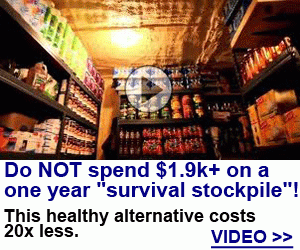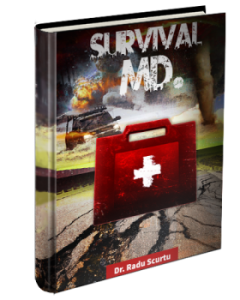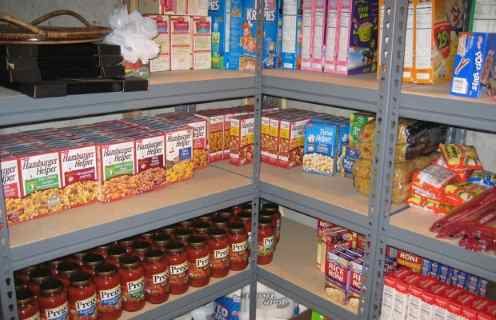Survival Prepper Items At Your Grocery Store
Budgets are tight. Times are tough, and likely to remain so for years to come. Hidden forms of inflation are eating away at our purchasing power. Very few among us can drop a lot of coin to accumulate survival supplies and prepper tools. Therefore most of us must accumulate our supplies incremental, slowly over time. For consumable items in your survival/prepper supplies, my recommendation is to simply add to your regular, reoccurring purchases. As an example, let say you spend $200 a week at the grocery store. Until such time that you build a year’s worth of food in your pantry, increase your grocery weekly purchases to $225 or $250 per week. Adding just $25 to your weekly grocery budget results in accumulating $1300 in consumables after just a year of effort. When this becomes a reoccurring regular practice, the incremental effort is very minimal — perhaps just a few minutes more at the grocery store. $1300 can represent a significant reserve of back-up food and water, in case of a disaster.
RELATED : Foods to Stock at Home and in Your Disaster Supplies Kit
Image yourself in a disaster situation. You are cold, hungry, tired, and your children haven’t been feed in two days. It is an unpleasant situation to imagine. Take a look at this picture after Hurricane Sandy to image what these people felt. Waiting in line for food after Hurricane Sandy. And more pictures found at: Hurricane Sandy: The Aftermath
RELATED : 6 Supplies You Need In Your Home As Hurricane Season Heats Up
Rather than waiting 3, 4 or more hours for food and water in a government relief line, a much more comfortable situation is having your own emergency supplies. My advice to every family is to have a minimum of one year’s of food reserves. And ideally two years are better. If managed properly, none of your food reserves ever goes to waste. Store what you eat and eat what you store. Most canned and dry goods purchased at a grocery store have 6 months to 24 months of shelf live. Many canned goods can last 3, 4 or even 5 years. Canned tuna and salmon commonly has a 5 year shelf life.
RELATED : Lindsey Williams – Warning to prepare for an emergency. Stock up on food, water and supplies now!
So why store a year’s worth of food? Hurricane Sandy was a contained regional disaster. Supplies from other parts of the country were flowing into the impact area within 24 hours after the storm. What if the disaster was on a national scale? Take a look at the situations in Spain, Argentina, Greece, Cyprus,  Portugal, and Slovenia. These countries have entered their own versions of a Great Depression. With a national level disaster, such as these countries’ current economic collapses, there is no aid coming from other parts of their own countries. Southern Spain is not sending aid to North Spain, because the entire country is in an economic depression. As a result, people are going hungry in these countries.
Portugal, and Slovenia. These countries have entered their own versions of a Great Depression. With a national level disaster, such as these countries’ current economic collapses, there is no aid coming from other parts of their own countries. Southern Spain is not sending aid to North Spain, because the entire country is in an economic depression. As a result, people are going hungry in these countries.
My worry in the near term for the United States is the risk of several natural disaster shocks occurring within a short time period. It is wild-fire and hurricane season in the United States. Tornadoes are hitting the Oklahoma region very hard this year. Wild fires are currently causing a lot of problems in California. So let’s image the possibility of these following events hitting the United States at nearly the same time:
RELATED : Top 20 Emergency Supplies We Recommend to Survive Any Disaster —
- Los Angeles is hit with an 8.5 scale earthquake, causing major damage to the South California region. Fires from gas pipe breaks and wild fires cover the entire region with smoke and smog.
- Miami is slammed with a level 4 hurricane, which completely inundates the entire city. Millions of people would need to evacuate up through the north of Florida into the gulf coast, Georgia, and the Carolinas.
- The Mississippi river has floods again. Perhaps it was from the result of the same hurricane that hit Miami and then went inland. The levees break causing St. Louis to be under 4 feet of water for weeks.
- A heat wave of over 100 degrees grips Northeast US for 30 days straight, causing a blackout in New York City due to demands of air conditioning on an under-invested electrical grid. All refrigerated food goes rotten. During the blackout, grocery and drug stores don’t operate due to reliance on electrical lighting and check-out computers. If the electrical grid is not restored within 3 days, riots and looting are inevitable.
RELATED : 55 Preparedness Items
The four major disaster scenarios, above, could possibly occur concurrently this summer. A 1-2-3-4 punch combined along with a nearly no-growth economic environment could easily cause the United States to enter another economic recession. An economic recession combined with the record levels of federal and state debt could evolve into the next Great Depression. An economic down turn along with the need to provide aid to four disasters concurrently would greatly overtax the government and likely exhaust the charity of ordinary citizens.
Is this an extreme, unlikely situation? Answer is yes, obviously. Is it within the realm of possibility. Yes, unfortunately. Global weather patterns are trend towards more extremes. The world is currently in a cycle of increase earthquakes. In the ring of fire around the Pacific ocean, stress had been diminished through earthquakes at nearly every point in the ring, except yet in Southern California. The folks in California have too short memories related to earthquake risks. I am very worried for Southern California and its people.
If several disasters occurred in close time proximity along with an economic recession, people and governments will run out of resources. And people will go hungry. Having a year’s worth of food stored for that rainy day, or flooding week, or heat wave month or an economic crash year. With the possibility of an economic recession along, millions are at risk of losing their jobs. Unemployment benefits and food stamps budgets are currently being cut. Having a year’s worth of stored food is a great aid for a high probability disaster event — where you become sick or lose your job. What a relief for your family, if you have a year’s worth of food set aside, if you become sick or lose your employment.
Okay, enough of the “why”. Let’s now talk about the “how”.
There are a vast number of survival/prepper supplies to gain at any grocery store. Below is a list of ideas to consider with your additional $25 or $50 per week added to your grocery budget.
RELATED : Doomsday Preppers Prepare for the End of the World
- Bottled water – Yes, I buy bottled water. I know it is not eco-friendly. It is for my survival pantry. I keep 20 one gallon bottles of water for each family member. This provides our family with a reserve of 20 days of water for drinking and cooking. I also buy cases of 1 pint (500 ml) water bottles when on sale. At anytime, I have 6 to 8 cases of 1 pint bottles. This water is designated for bug-out situation and to maintain each vehicle with their own emergency travel supply of drinking water. If a disaster event occurs, I’ll refill the empty water bottles from water purified through my Berkey water filter. The 1 pint plastic water bottles makes it easer to give to my neighbors who might need water after a disaster event.
- Batteries — The first time you experience a power outage, you appreciate having a reserve of batteries. Just two months ago, a drunk driver knocked down a primary distribution pole in my hometown. Power with out for 24 hours. Just try to find the toilet in pitch black at 3:00 AM without a flashlight. In the middle of the night with good lighting, I already have trouble with my bathroom aim. My battery storage include rechargeable and non-rechargeable batteries. I store a lot of batteries. Just like food, if you rotate your batteries, they will not go to waste. The rechargeable batteries are reserved for a long-term disaster event. Non-rechargeable batteries are utilized for everyday usage. I’m too busy and too disinterested in continually recharging batteries everyday. But in a WROL or TEOTWAWKI situation, I expect to have time on my hands to juggle rechargeable batteries.
- Canned food – Canned food is a marvel of modern science. The technology regarding canned food continues to improve and extend the shelf life of food. Most food companies have realized the hazards of BPA coatings, and most are moving away from BPA. A primary component of your first year’s worth of food supplies should be in canned food. You can build a diverse, fully nutritional diet just from canned goods. Canned meat, beans, soups, fruits, nuts, snacks, and vegetables are very easily prepared as meals. Most canned food can be eaten without heating. Equally, this include food in vacuum sealed glass jars, such as pickles, pasta sauce, jellies, jams, olives, etc. Recently I bought a half case of Morello cherries at Trader Joes, which were grown in Germany – delicious! I don’t emphasis dried foods, such as pasta, rice, and dried beans for short-term disasters. I have ample stores of these dry good items for long-term disasters. But in a short-term disasters, boiling water for food preparation can be inconvenience, and perhaps dangerous in a damaged home. I have between 2 and 3 years worth of stored food at my home. The vast majority of my short-term food reserves are in cans and jars. My long-term food storage does include lots dried goods, including #10 cans and superpails from suppliers who specialize in long-term stored food. When my in-laws show up and the neighbors knock at the front-door, that 30 months of stored food become 10 months of stored food. All of this food is money in the bank, since the food is actively rotated. One of our family meals this past week was tuna melt sandwiches, where the tuna was purchased 3 years ago at a cheaper price.
- Sterno Fuel Containers — Sterno is a jellied alcohol which you will typically be seen under chaffing dishes on a buffet. Sterno burns very cleanly without smoke. These are idea for short-term food cooking. I have several cases of sterno fuel cans. For a short-term disaster, I’ll set a can of sterno in a small portable stove on top of the kitchen stove.
- Tea Bags – I love, want and perhaps need coffee. Making coffee after a disaster is truly inconvenient and messy. I have lots and lots of bagged tea as a back-up. Tea stores very well for time periods longer than coffee. Stored roasted coffee goes bad after a year. In China, some tea has been aged and treasured for dozens of years. Your tea bags will keep for a couple of years, where coffee will not. If you want caffeine after a disaster, tea bags are the way to go. Tea has wonderful antioxidant properties. Also have chamomile tea has a calming effect and improves health after a sickness.
- Candles — Plain, white tea light candles are excellent for short and medium-duration disaster events. In a power outage situation, I’ll burn a tea light in the bathroom during the evening. A couple of times each year, I’ll toss a bag of tea light candles into the grocery cart. And when seeing other times of candles on sale, I’ll consider those as well.
- Paper Plates / Plastic Utensils — In a short or medium-term duration disaster, it is a royal pain to wash dishes. Dirty dishes quickly stack up without access to clean, fresh water. It is much more convenient and sanitary to use paper plates and plastic utensils on a short-term basis.
- Thick, Dark Trash Bags – During a disaster event, it is highly likely you’ll be cleaning up debris. You’ll need more large trash bags than you think. The folks impacted by tornadoes in Oklahoma the past month, they had more than their fair share of debris clean-up. Large trash bags are useful for collecting your recovered material possessions after a disaster. If your home is damaged and exposed to the weather, store your valuables (such as clothing, art, collectibles, paper records, electronics, and physical photographs) in trash bags to prevent further damage. Also utilize trash bags for very temporary patches to damaged windows, walls, and roof. A simple rain after a disaster event can cause unrecoverable damage to your stuff.
- Zip Lock Bags – Has 100′s of uses, including creating distributable meals for your neighbors, saving leftover food, protecting medicines from moisture, protecting valuables from moisture, and many more.
- Baby Wipes / Toddler Wipes — Even though my children are out of diapers, my wife still buys and stores wipes. Toddler wipes are excellent for daily bathroom cleanliness. In the event of a disaster, baby wipes and toddler wipes are key items to preserve personal cleanliness. After a major disaster, don’t expect to be taking a shower or bath for an extended time period. Baby wipes can replace a bath or shower for weeks. Astronauts while in space use baby wipes in place of bathing. When you can’t bathe for weeks at a time, toddler wipes will keep your bum nicely clean.
- Vinegar – Vinegar is a natural, non-toxic fluid for sanitation and cleaning. It is difficult to use harsh chemical cleaners, such as ammonia based cleaners, after a disaster. You need plenty of water to rinse away chemical cleaners. Rather and easier, use vinegar mixed with water to clean counter-tops, sinks, toilets, glassware, dishes, utensils, pots and pans. Vinegar doesn’t need a lot of water for rinsing. Once vinegar evaporates, you have a cleaner surface. After the initial disaster, poor sanitation and tainted water cause the vast majority of secondary deaths. Vinegar is every effective for maintain cleanliness at your home after a disaster.
- Hard Candies – I aways keep several large bags of hard candies ready for disaster situations. Boiled sweets, as the Brit’s call them, are little treasures of stored human energy. After a disaster, you’ll be working the entire day to recover and cleanup. And possibly you’ll be walking everywhere. Hard candies can provide you with a little energy boast while you work hard. And it gives the kids a bit of an occasional treat and divert their attention away from a trauma event. Generally, our family doesn’t eat much if any candy. Our occasional food vice is chocolate and ice cream, neither of which are likely available after a disaster. Hard candies, such as Jolly Rancher, stores for many years, since their primary content is sugar. Sugar naturally preserves itself, if kept dry, cool, and covered. Thus I keep a small bag of hard candies in my EDC bag and several large bags hard candies in my bug-out food kit. If a disaster event hits my neighborhood, I expect to be distributing the hard candies to the kids up and down my block.
- Save the used grocery bags – After you bring home your weekly groceries, SAVE the plastic and paper grocery bags. The used grocery bags are very valuable for collecting trash and preserving sanitation. Often after a major storm or flooding, you not be able to flush the toilet. You’ll need to improvise of toilet. In this contingency, I have a plastic toilet seat that is specifically designed to fit over a standard 10 gallon white food bucket. I’ll place used grocery bags under the portable toilet seat. After a couple uses, I’ll then will double and triple bag the human wastes, then store in a larger black trash bag. In this approach, I am able to achieve months of sanitary conditions. In a long term disaster, human wastes must be buried deeply (5 feet minimum) and away from any public water sources. You can use the used grocery bags to collect other trash and organize household goods that might need to be moved away from a damaged home. I have a collection of used grocery bags in my bug-out kit for the same reasons.
- Hand sanitizer – As mentioned several times already, sanitation is a key element of staying healthy after a disaster. Expect your hands to be dirtier, as you clean-up and make repairs. Access to running water might be interrupted. Hand sanitizer should be used frequently throughout the day before and after a disaster event.

- Medical supplies that go on sale — When we do our weekly grocery runs, we’ll keep our eyes our for sales of medical supplies. Occasionally, there will be a two-for-one sale on vitamins or pain relievers. Bandages and first aid supplies will occasionally show up in the discount bin. Cold medicines out of season, such as now in the Summer, go on sale. Over the counter cold/flu medicine has become ridiculously expensive. I’ll buy in the Summer to save money in the coming Winter. Most people simply do not have enough medical and first aid supplies. A couple of boxes of band aids and gauze pads are not enough. Having dealt with a draining infection in my arm this past couple of weeks, I went through 10 boxes of gauze, bandages, and medical tape. Just one injury or severe cut can exhaust the stored first-aid supplies for most families. After a disaster, drug stores will be closed or emptied. You must have your own deep stores of medical supplies and first aid supplies.
- Aluminum Foil – 100′s of uses, including covering jars and cans, making an ad hoc solar oven, protecting electronic equipment, etc. Aluminum foil stores forever. Whatever you buy today will save you money tomorrow.
- Matches, Lighters – To light the sterno, barbecues, camp fires, and candles.
- Garden seeds out of season – Garden seeds are viable for 2 to 10 years, depending on the type of fruit or vegetable. Garden seeds go on sales after garden planting season is over.
- Out of Season Goods – One of the best ways to save money is to buy storable good out of season. Stores will discount out of season items to make space for in-season goods. Best time to buy holiday wrapping paper is December 26th. Best time to buy hard candy is November 1st. Best time to buy grilling supplies is after Labor Day. And so on…
RELATED : 100 ITEMS TO DISAPPEAR FIRST
Notice that alcohol (beer, wine, hard liquor) is not on this list. After a disaster, alcohol will dehydrate you. And it will not make you clear thinking, when instead you need to work very hard. And that is the time to be very vigilant with your safety. Crack a beer only after the recovery is well at hand. Being drunk during a disaster event is just so f****** stupid.
No doubt you can think of many more items to add to this list. Best way to approach this is simply look at your grocery receipts over the past couple of months. Of whatever you buy on a regular basis, buy more than you need. Build up your supplies until you have banked away a solid reserve. As food and household goods continue to increase in price, your stored food will save your money over time. Groceries will often have loss-leading items on sale to attract buyers to the store. When green beans go on sale, buy two cases instead of two cans. Then eat down your stored green beans over the next year. In this way, you save money in the long run. And when a disaster strikes your home, your neighborhood, your life…you will be grateful for your forethought and preparations. In a short-term regional disaster, FEMA is your friend and savior. In a multi-year national economic collapse scenario, you will represent just a sad statistic on a FEMA status report. That is unless you are self-reliant and prepared. Don’t stand in line. Rather stand your ground. And eat the food that you want to eat, before and after a disaster.(source)
RELATED : FEMA CAMP ROUND UP HAS BEGUN!!!
Prepping: Why So Much Canned Food Healthy Prepper? Its so Unhealthy! What Gives??
How to Prepare Yourself for a Food Shortage
RELATED : Things You Must Do Before Economic Collapse Coming – September 2015
Survival MD (Best Post Collapse First Aid Survival Guide Ever)
Backyard Innovator (A Self Sustaining Source Of Fresh Meat,Vegetables And Clean Drinking Water)
Blackout USA (EMP survival and preparedness)
Conquering the coming collapse (Financial advice and preparedness )
Liberty Generator (Build and make your own energy source)
Backyard Liberty (Easy and cheap DIY Aquaponic system to grow your organic and living food bank)
Bullet Proof Home (A Prepper’s Guide in Safeguarding a Home )
Family Self Defense (Best Self Defense Strategies For You And Your Family)
Sold Out After Crisis (Best 37 Items To Hoard For A Long Term Crisis)
Survive The End Days (Biggest Cover Up Of Our President)
Drought USA(Discover The Amazing Device That Turns Air Into Water)



